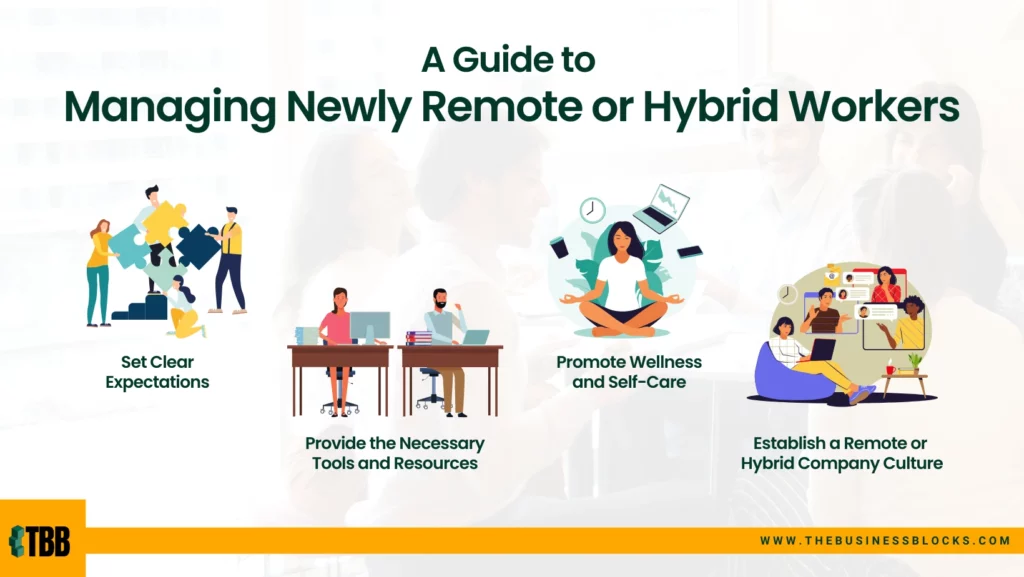The transition to remote and hybrid work has been a major challenge for many organizations. It’s almost three years since the global pandemic forced much of the planet into working from home, but many organizations are still struggling to make the most of the remote working model.
Managing fully remote and hybrid workstyles requires a combination of thoughtful strategies and effective communication. Employers must be clear about expectations, provide the necessary tools and resources, and create an environment conducive to collaboration and productivity.
By taking the time to understand the unique needs of their remote and hybrid workforce, employers can successfully lead their teams to success.
Whether you’re new to managing a remote team, or you’re still yet to master the art of leading a hybrid workforce, fear not — we’ll guide you through how to make the most of it.

Set Clear Expectations
As a manager, it’s your job to set clear expectations and be transparent about the realities of remote and hybrid work. There are plenty of benefits to both remote and hybrid working environments, but it’s important not to ignore the potential pitfalls, too.
Make sure your employees understand that working from home requires a high level of trust from a management perspective. Of course, it’s important to avoid micromanaging your team members — this will only breed resentment — and instead ensure that your team understands that their productivity needs to remain consistent. A great way to do this is to schedule in regular catch-ups. This will allow you to get a sense-check of your team’s productivity and workloads in a relaxed and informal manner.

It’s also worth writing up a remote and hybrid working policy. This can come in handy, for example, should you want to ensure that all of your employees attend important company meetings in person. Your written policy may include details on how many days your workers are expected to attend the office, or guidelines around the use of company property outside of the office — office chairs, laptops, keyboards, etc.
Provide the Necessary Tools and Resources
It should come as no surprise that communication is one of the most critical aspects of managing a remote or hybrid workforce. With all your employees operating on different schedules (and potentially spread across the globe), it can be easy for important conversations and information to get lost in the shuffle.
This is why ensuring your team is kitted out with the right tools for the job is important. Instant messaging services such as Slack do a great job of keeping everyone in touch. For video conferencing, Microsoft Teams and Google Meet are two popular options. Google’s Workspace suite is fantastic for real-time collaboration, too. By now, most employees should be more than comfortable operating these (or similar) tools, but don’t forget to offer training for anyone less familiar with how they work.
Are your team all equipped with suitable home working setups? If not, it’s your responsibility to make sure their remote workspaces are just as comfortable — and safe — as their office desks. You may choose to loan out your office’s excess furniture or compensate your workers for any new equipment they order themselves. In any case, make sure your team has all the necessary hardware, software, and equipment they need to get the job done.

Promote Wellness and Self-Care
If your team is new to working from home, they may struggle to make the adjustments, and some employees’ mental health may take a knock. Usually, this will be a result of burnout and isolation. Encourage your staff to reinforce the line between work and home by:
- Setting up a home office: A designated workspace will not only narrow one’s focus, but will also enable your employees to create a clear divide between their work and home lives, improving their overall work-life balance.
- Encouraging a daily routine: The structure of a set schedule can ensure that your employees don’t feel tempted to work past their allocated hours, and that they feel confident they can complete all of their assigned tasks within a reasonable timeframe.
- Conducting team check-ins: Catch-ups aren’t just useful for monitoring your team’s productivity, they’re also great for checking how they’re feeling, too. Ask them how their workload is, if they’re feeling stressed, or if they’d like to take a break soon and use some of their holiday allowances. Sure — there’s a fine line between being friendly and acting professionally, but it’s well worth developing a personable relationship with your workers.

Perhaps your team is suffering from cabin fever? Nowadays, it’s entirely possible to manage a global team, so why not allow your employees to relocate to greener pastures? When contemplating this, there are various relocation costs to consider — from travel expenses to adjustments in salaries due to cost of living differences. Remote provides an employer of record service which will handle the entire local employment process from end to end, so you can enable your employees to work remotely from another location or country entirely — whether temporarily or on a permanent basis. Better yet, making use of an EOR service will allow you to recruit on a global scale — perfect if it’s challenging to find qualified locally-based candidates.
Establish a Remote or Hybrid Company Culture
Following on from our last point about the dreaded cabin fever that many remote workers suffer from, let’s talk about workplace culture. Just because your team isn’t physically meeting up on a regular basis (or at all), this shouldn’t mean that company culture is left to erode and disappear. As a manager, it’s your job to preserve the culture of your team.
The best way to do this is through organized company socials. There are plenty of providers offering remote work socials. From ‘drag queen bingo’ and online karaoke to virtual escape rooms — there’s something to suit all tastes. This isn’t to say that in-person social events should be written off altogether. Even if most of your employees prefer to stay away from the office, events such as Christmas are a great excuse to bring everyone together.
Still, creating a healthy company culture while many — or all — of your employees are working remotely needn’t require anything too over-the-top. Simply encouraging informal meetings and catch-ups — replicating the ‘water-cooler chat’ often enjoyed in an office — can keep morale high. And don’t forget that recognition goes a long way, too, so ensure you’re recognizing and rewarding the achievements of your top-performing employees.

Transitioning from the office to a remote or hybrid workspace can be tricky, but by following the guidelines above, both you and your team should find the process relatively hassle-free. And, once everyone’s up and running, you’ll wonder why it took you and your team so long to take the plunge!
